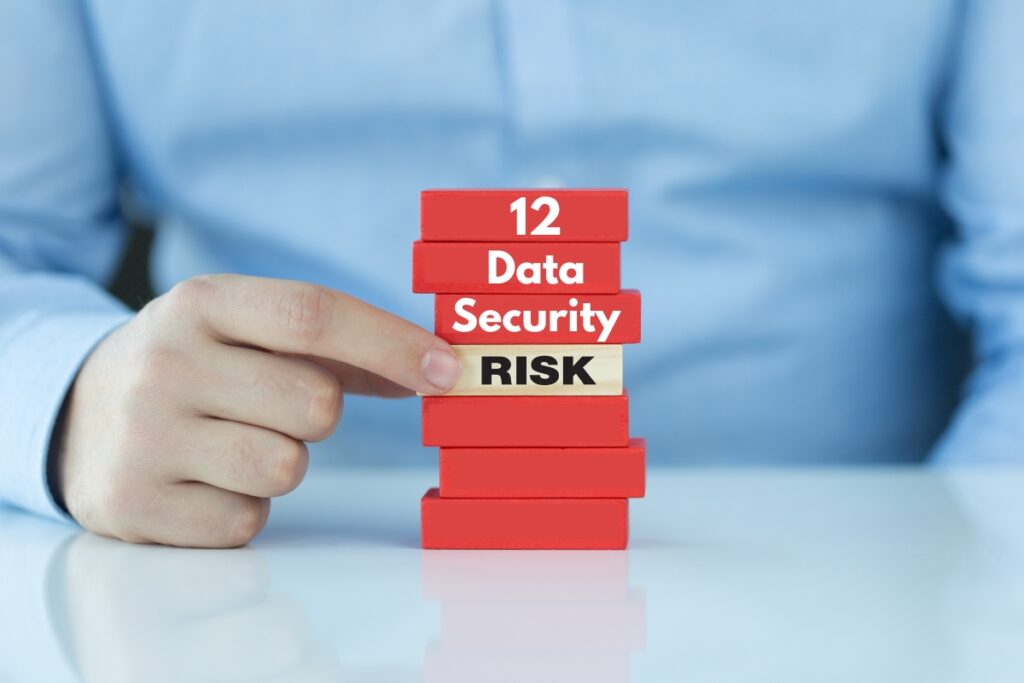Ever had that sinking feeling when you realize you just emailed sensitive client information to the wrong person?
Or maybe you’ve wondered if that weird email from your “CEO” asking for customer data is actually legitimate?
These moments of panic highlight the very real data security risks that businesses face every day. For law firms, healthcare practices, and professional service providers, these risks directly threaten not just your operations, but your client relationships, regulatory compliance, and ultimately your business survival.
Let’s get into the critical data protection risks you need to understand and address before they become costly disasters.
8 Critical Data Security Risks Threatening Your Business

1. Ransomware Attacks: Encrypting Your Business Data
Ransomware has become the nightmare scenario for businesses of all sizes. This malicious software encrypts your files and demands payment for the decryption keys, with attacks now occurring every 11 seconds according to Cybersecurity Ventures.
These attacks typically spread through phishing emails, malicious downloads, or by exploiting system vulnerabilities. The impact is devastating – imagine a law firm suddenly unable to access case files, a healthcare practice locked out of patient records, or an accounting firm that can’t access client financial data.
Prevention requires a multi-layered approach combining email protection, network firewall security benefits, endpoint security, and most importantly, proper data backup and recovery in cloud computing solutions that allow rapid restoration without paying ransom.
2. Phishing and Social Engineering Attacks
Phishing attacks trick employees into revealing credentials, downloading malware, or transferring sensitive information through deceptive emails that appear legitimate. These attacks exploit human psychology, making them particularly effective – over 90% of data breaches begin with phishing, according to Verizon’s Data Breach Investigations Report.
Common scenarios include:
- Fake emails appearing to come from the CEO requesting confidential information
- Convincing login pages that steal credentials
- Urgent requests are creating pressure for quick action without verification
- Targeted attacks researching specific employees and their connections
The importance of IT services that include email security and employee awareness training becomes clear when you realize technology alone can’t stop these human-focused attacks
3. Insider Threats and Employee Data Misuse
One of the most overlooked data privacy risks comes from within your organization. Whether through malicious intent or simple negligence, insider threats from employees, contractors, or partners with legitimate access cause approximately 60% of data breaches.
These threats are particularly dangerous because insiders:
- Know where valuable data is stored
- Have authorized access that doesn’t trigger security alerts
- Understand internal systems and security measures
For professional services handling confidential information, these risks are amplified. A disgruntled employee downloading client files before leaving, a curious staff member browsing patient records, or a contractor exploiting system access can all create devastating data breaches.
Understanding what is an insider threat cyber awareness is essential for protecting against these internal risks.
4. Weak Passwords and Credential Theft

Despite years of warnings, password vulnerabilities remain one of the most common data risks.
Weak, reused, or stolen passwords enable unauthorized access to systems and sensitive information. Approximately 80% of breaches involve compromised credentials, according to Microsoft security research.
| Common Password Vulnerabilities | Risk Level | Mitigation |
| Reusing passwords across systems | Extreme | Implement unique passwords for each service |
| Simple, easily guessed passwords | High | Require complex passwords with minimum requirements |
| Sharing credentials among team members | High | Provide individual accounts with appropriate permissions |
| Lack of multi-factor authentication | Extreme | Implement MFA for all business systems |
When credentials are compromised, attackers can operate within your systems, appearing as legitimate users, often remaining undetected for months while accessing sensitive data.
5. Unpatched Software Vulnerabilities
Outdated software with unpatched security flaws provides easy entry points for attackers. Software vendors regularly release security updates fixing discovered vulnerabilities, but businesses often delay these updates, leaving systems exposed to well-known exploits.
Major security incidents like the WannaCry ransomware outbreak exploited vulnerabilities that had patches available for months, but many organizations had failed to install them. A single unpatched system can compromise an entire network, making regular updates a critical security practice.
6. Inadequate Data Backup and Recovery Capabilities
If there’s one security investment that provides the clearest return, it’s proper backup systems. Yet many businesses maintain inadequate or untested backup processes that fail when needed most.
Common backup failures include:
- Backups running irregularly or manually
- Backup copies stored only on-site (vulnerable to the same disasters)
- Backups are never tested until an actual emergency
- Insufficient retention periods
The consequences can be catastrophic. According to the U.S. Bureau of Labor Statistics, approximately 60% of businesses that experience major data loss close within six months.
7. Mobile Device Security Gaps
Smartphones and tablets accessing business email, documents, and applications often lack adequate security controls, creating significant exposure risks. These devices are easily lost or stolen, connect to insecure networks, and frequently mix personal and business data.
For professional services where attorneys, healthcare providers, or financial advisors routinely access highly confidential information on mobile devices, these risks require specific policies and technical controls, including:
- Device encryption
- Mobile device management
- Remote wipe capabilities
- Secure communication apps
- Clear security policies
The data security vs cyber security distinction becomes important here, securing the devices is different from securing the data itself.
8. Compliance Violations and Regulatory Risks
Beyond the direct security threats, failing to implement required data protection controls results in regulatory violations, fines, and legal liability. For regulated industries, these compliance failures can be business-ending even without an actual breach.
- Healthcare practices face HIPAA fines up to $1.5 million per violation category.
- Law firms must meet ABA ethics requirements for client confidentiality
- Financial services have strict requirements under various regulations
- Any business handling payment cards must meet PCI DSS standards
Compliance requirements increasingly mandate comprehensive data security, including encryption, access controls, monitoring, and regular assessments.
Understanding data security vs data protection is critical for meeting these regulatory obligations.
How to Protect Your Business From These Data Security Risks
Addressing these threats requires a comprehensive approach combining technical controls, policies, and human awareness:
- Implement layered security defenses, including firewalls, endpoint protection, and email security
- Deploy data protection measures, including enterprise data encryption and access controls
- Ensure comprehensive backup and disaster recovery capabilities with regular testing
- Provide regular security awareness training for all employees
- Maintain compliance with regulatory requirements specific to your industry
- Implement network availability monitoring to detect suspicious activities
- Keep systems patched and updated with the latest security fixes
- Establish clear security policies and ensure they’re followed
The 10 reasons why cybersecurity is important become painfully clear when you understand these risks and their potential business impact. Effective data security requires an integrated approach addressing technical, human, and procedural factors.
For most businesses, partnering with experienced IT security professionals provides the expertise needed to navigate these complex threats and implement appropriate protections.
Frequently Asked Questions
What is the biggest data security risk for businesses?
People. Human error and social engineering cause more data breaches than technical vulnerabilities. Employees clicking phishing links, using weak passwords, or mishandling sensitive data represent the largest security gap for most organizations.
How can businesses reduce data security risks?
Implement layered security with firewalls and endpoint protection, use encryption and access controls, maintain tested backups, provide regular employee security training, keep systems updated, and partner with security experts for guidance.
What are the consequences of data security breaches?
Immediate financial losses, operational disruption, regulatory fines, legal liability, client trust damage, and long-term reputation harm. For small businesses, major breaches often lead to closure within months.
Do small businesses face the same data security risks as large companies?
Yes, and often with more severe consequences. Small businesses face identical threats but typically have fewer resources for protection and recovery. Attackers increasingly target smaller organizations precisely because they’re often less defended.
Wrapping Up
Data security risks are daily realities that businesses face in an increasingly digital world.
Understanding these risks is the first step toward implementing effective protection that safeguards your sensitive information, maintains regulatory compliance, and ensures business continuity even when the inevitable occurs. With proper planning, appropriate technology, and expert guidance, you can transform data security from a source of anxiety into a foundation of confidence that your critical business information remains protected.
Ready to address the data security risks threatening your business? Contact us today for a comprehensive security assessment that identifies your specific vulnerabilities and develops protection strategies tailored to your unique business needs.


